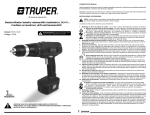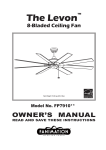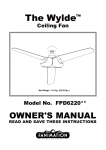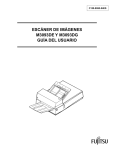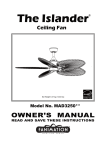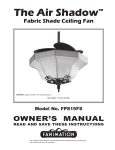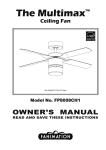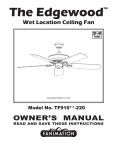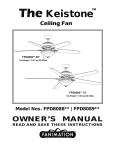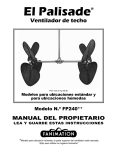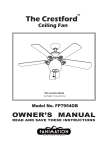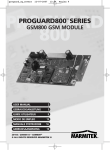Download The Bayhill™ - Del Mar Fans and Lighting
Transcript
The Bayhill ™ Collection LB250VZ Net Weight 11.8 kg (26 lbs) LB230VZ Net Weight 18.0 kg (39.7 lbs) LB270VZ Net Weight 18.3 kg (40.4 lbs) Models No. LB250VZ, LB230VZ & LB270VZ OWNER’S MANUAL READ AND SAVE THESE INSTRUCTIONS Important Safety Instructions WARNING: To avoid fire, shock and serious personal injury, follow these instructions. 1. Read your owner’s manual and safety information before installing your new fan. Review the accompanying assembly diagrams. 2. Before servicing or cleaning unit, switch power off at service panel and lock service panel disconnecting means to prevent power from being switched on accidentally. When the service disconnecting means cannot be locked, securely fasten a warning device, such as a tag, to the service panel. 3. Be careful of the fan and blades when cleaning, painting, or working near the fan. Always turn off the power to the ceiling fan before servicing. 4. Do not insert anything into the fan blades while the fan is operating. 5. Do not operate reversing switch until fan blades have come to a complete stop. Additional Safety Instructions 1. To avoid possible shock, be sure electricity is turned off at the fuse box before wiring, and do not operate fan without blades. 2. All wiring and installation procedures must satisfy National Electrical Codes (ANSI/ NFPA 70-1999) and Local Codes. The ceiling fan must be grounded as a precaution against possible electrical shock. Electrical installation should be made or approved by a licensed electrician. 3. The fan base must be securely mounted and capable of reliably supporting at least 50 lbs. See page 4 of owner’s manual for support requirements. Consult a qualified electrician if in doubt. 4. The fan must be mounted with the fan blades at least 7 feet from the floor to prevent accidental contact with the fan blades. 5. Follow the recommended instructions for the proper method of wiring your ceiling fan. If you do not have adequate electrical knowledge or experience, have your fan installed by licensed electrician. WARNING: This product is designed to use only those parts supplied with this product and/or accessories designated specifically for use with this product. Using parts and/or accessories not designated for use with this product could result in personal injury or property damage. WARNING: To reduce the risk of personal injury, do not bend the blade bracket (flange or blade holder) when installing the brackets, balancing the blades, or cleaning the fan. Do not insert foreign objects in between rotating fan blades. LIMITED LIFETIME WARRANTY Extends to the original purchaser of a Fanimation Fan 1. LIMITED LIFETIME MOTOR WARRANTY - If any part of your fan motor fails, due to a defect in materials or workmanship during the lifetime of the original purchaser, Fanimation will provide the replacement part free of charge, when the defective fan is returned to our national service center. Proof of purchase is required. Customer shall be responsible for all costs incurred in the removal or reinstallation and shipping of the product for repairs or replacement. 2. ONE YEAR MOTOR LABOR WARRANTY - If your fan motor fails at any time within one year from the original purchase, due to defects in materials or workmanship, labor to repair the motor will be provided free of charge at our national service center. Purchaser will be responsible for labor charges after this one-year period. Customer shall be responsible for all costs incurred in the removal or reinstallation and shipping of the product for repairs or replacement. 3. If any other part of your fan fails at any time within one year after original purchase, due to a defect in materials or workmanship, we will repair, or replace, at our option, the defective part free of charge for parts and labor performed at our national service center. 4. Because of varying climate conditions, this warranty does not cover changes in the finish, including rusting, pitting, corroding, tarnishing, or peeling. 5. This warranty is void and does not apply to damage from improper installation, neglect, accident, misuse, exposure to extremes of heat or humidity, or as a result of any modification to the original product. 6. All costs of removal and reinstallation of the fan are the sole responsibility of the owner of the fan and not the store that sold the fan or Fanimation. 7. Fanimation reserves the right to modify or discontinue any product at any time and may substitute any part under this warranty. 8. Under no circumstances may a fan be returned without prior authorization from Fanimation. The receipt of purchase must accompany authorized returns and must be sent freight prepaid to Fanimation. The fan to be returned must be properly packed to avoid damage in transit; Fanimation will not be responsible for any damage resulting from improper packaging. 9. It is understood that any repair or replacement is the exclusive remedy available from Fanimation. There is no other expressed or implied warranty. Fanimation hereby disclaims any and all implied warranties, including, but not limited to those of merchantability and fitness for a particular purpose to the extent permitted by law. Some states do not allow limitations on implied warranties. Fanimation will not be liable for incidental, consequential, or special damages arising out of or in conjunction with product use or performance, except as may otherwise be accorded by law. This warranty gives you special legal rights and you may also have other rights that vary from state to state. 10. A certain amount of wobble is normal and should not be considered a problem or a defect. Table of Contents Unpacking Instructions . . . . . . . . . . . . . . . . . . . . . . . . . . . . . . . . . . . . . . . 3 Electrical and Structural Requirements . . . . . . . . . . . . . . . . . . . . . . . . . .4 How to Assemble Your Ceiling Fan . . . . . . . . . . . . . . . . . . . . . . . . . . . . .4 How to Hang Your Ceiling Fan . . . . . . . . . . . . . . . . . . . . . . . . . . . . . . . . . 6 How to Wire and Operate Your CW2WH Wall Control . . . . . . . . . . . . . . . 7 Installing the Canopy Housing . . . . . . . . . . . . . . . . . . . . . . . . . . . . . . . . .8 Assembling and Mounting the Fan Blades, & Adapter/Switch Hsg . . . 8 Maintenance . . . . . . . . . . . . . . . . . . . . . . . . . . . . . . . . . . . . . . . . . . . . . . .10 Blade Cleaning . . . . . . . . . . . . . . . . . . . . . . . . . . . . . . . . . . . . . . . . . . . . .10 Trouble Shooting . . . . . . . . . . . . . . . . . . . . . . . . . . . . . . . . . . . . . . . . . . . 11 Parts List – LB250VZ . . . . . . . . . . . . . . . . . . . . . . . . . . . . . . . . . . . . . . . .12 Exploded-View Illustration – LB250VZ . . . . . . . . . . . . . . . . . . . . . . . . . .13 Installation Instructions – LKLB230VZ. . . . . . . . . . . . . . . . . . . . . . . . . .14 Service Parts – LKLB230VZ. . . . . . . . . . . . . . . . . . . . . . . . . . . . . . . . . . .15 Installation Instructions – LKLB270VZ. . . . . . . . . . . . . . . . . . . . . . . . . .16 Service Parts – LKLB270VZ. . . . . . . . . . . . . . . . . . . . . . . . . . . . . . . . . . .17 This Manual is Designed to Make it as Easy as Possible for You to Assemble, Install, Operate, and Maintain Your Ceiling Fan Tools Needed for Assembly • One Phillips head screwdriver • One stepladder • One ¼"blade screwdriver Materials • One wire stripper • Three wire connectors (supplied) Wiring outlet box and box connectors must be of type required by local code. The minimum wire would be a 3conductor (2-wire with ground) of the following size: ▲WARNING Before assembling your ceiling fan, refer to section on proper method of wiring your fan (page 7). If you feel you do not have enough wiring knowledge or experience, have your fan installed by a licensed electrician. Installed Wire Length Wire Size A.W.G. Up to 50 ft. 50 - 100 ft. 14 12 NOTE: Place the parts from the loose parts bags in a small container to keep them from being lost. If any parts are missing, contact your local retailer. Unpacking Instructions For your convenience, check-off each step. As each step is completed, place a check mark. This will ensure that all steps have been completed and will be helpful in finding your place should you be interrupted. • Fan Motor assembly • Motor Coupler Cover • Housing Switch Cup/ Adapter assembly • Hanger Bracket with Shoulder Screws • Downrod/Hanger Ball • Ceiling Canopy • Canopy Screw Cover assembly • Blade Holder (4) • Wood Blades (4) • Candelabra Bulbs (3) • CW2WH Wall Control ▲WARNING Do not install or use fan if any part is damaged or missing. This product is designed to use only those parts supplied with this product and/or any accessories designated specifically for use with this product by Fanimation. Substitution of parts or accessories not designated for use with this product by Fanimation could result in personal injury or property damage. Contact your retail store for missing or damaged parts. 1. Check to see that you have received the following parts: • Hardware bags: – Nine ¼-20 x 14mm (blade holder to fan motor hub) screws – Thirteen 3/16-24 x 15mm (blade to blade holder) pan-head screws, fiber & flat washers – Four wire connectors – Ceiling Support Cable with clamp – Flat washer – Lag bolt – Fanimation screwdriver NOTE: If you are uncertain of part description, refer to exploded view illustration. (Figure 1, page 13) Hanger Bracket Downrod/ Hanger Ball Assembly Ceiling Canopy Canopy Screw Cover Motor Coupler Cover CW2WH Wall Control Candelabra Bulbs 40W (3) Blade Holders Fan Motor Assembly Switch Cup/Adapter Housing Assembly Hardware Bags NOTE: The illustration shown is not to scale or its actual configurations may vary 3 Wood Blades Electrical and Structural Requirements Your new ceiling fan will require a grounded electrical supply line of 120 volts AC, 60 Hz, 15 amp circuit. The outlet box must be securely anchored and capable of withstanding a load of at least 50 lbs. Figure 1 depicts different structural configurations that may be used for mounting the outlet box. Ceiling ▲WARNING Ceiling Joists To reduce the risk of fire, electrical shock, or personal injury, mount fan to outlet box marked acceptable for fan support of 22.7 kg (50 lbs) or less. Use screws supplied with outlet box. Most outlet boxes commonly used for support of light fixtures are not acceptable for fan support and may need to be replaced. Consult a qualified electrician if in doubt. 2˝ x 4˝ Outlet Box If your fan is to replace an existing light fixture, turn electricity off at the main fuse box at this time and remove the existing light fixture. Figure 1 ▲WARNING ▲WARNING Turning off wall switch is not sufficent. To avoid possible electrical shock, be sure electricity is turned off at the main fuse box before wiring. All wiring must be in accordance with National and Local codes and the ceiling fan must be properly grounded as a precaution against possible electrical shock. To avoid fire or shock, follow all wiring instructions carefully. Any electrical work not described in these instructions should be done or approved by a licensed electrician. How to Assemble Your Ceiling Fan 1. Remove the Hanger Ball by loosening the setscrew in the Hanger Ball until the ball falls freely down the Downrod. (Figure 1) Remove the Pin from the Downrod, then remove the Hanger Ball. Retain the Pin and Hanger Ball for reinstallation in Step 5. Pin Hanger Ball 2. The fan comes with blue, black, and white 80˝ wires and support cable. Separate and untwist the three wires and support cable. Route the wires and cable through the Downrod. Setscrew NOTE: You will be using either the 6˝ downrod supplied with your fan or an optional downrod purchased separately. Figure 1 4 How to Assemble Your Ceiling Fan (cont’d) 3. Loosen the two setscrews in the Downrod Support. Align the Clevis Pin holes in the Downrod with the holes in the Downrod Support. Install the Clevis Pin and secure with the Hairpin Clip. (Figure 2) Be sure to push the straight leg of the hairpin clip through the hole near the end of the clevis pin until the curved portion of the hairpin clip snaps around the clevis pin. The hairpin clip must be properly installed to prevent the clevis pin from working loose. Pull on the Downrod to make sure the clevis pin is properly installed. Downrod Support Hairpin Clip Clevis Pin Setscrew (2) 4. While pulling up on the Downrod, securely tighten the two 3/16-24 x 3/8˝ setscrews in the downrod support. (Figure 3) Figure 2 5. Route wires through opening in Motor Coupler Cover and Canopy. Position Canopy on fan shown with open side facing up. (Figure 3) 6. Reinstall the Hanger Ball (Figure 1) on the Downrod as follows. Route the three 80˝ wires and support cable through the Hanger Ball. Position the Pin through the two holes in the Downrod and align the Hanger Ball so the Pin is captured in the groove in the top of the Hanger Ball. Pull the Hanger Ball up tight against the pin. Securely tighten the setscrew in the Hanger Ball. A loose setscrew could create fan wobble. ▲WARNING Downrod Ceiling Canopy Pin Setscrew Canopy Screw Cover It is critical that the clevis pin in the downrod support is properly installed and the setscrews are securely tightened. Failure to verify that the pin and setscrews are properly installed could result in the fan falling. NOTE: The setscrews must be properly installed as described above, or fan-wobble could result. Motor Coupler Cover 7. The fan comes with blue, black, and white leads. Before installing fan, measure up approximately 6-9 inches above top of Downrod/Hanger Ball Assembly. Cut off excess wire and strip back insulation ½˝ from end of wire. 8. You have now completed the upper assembly of your new ceiling fan. You can now proceed with the hanging and the electrical wiring of your fan. 5 Figure 3 How to Hang Your Ceiling Fan ▲WARNING Ceiling To avoid possible electrical shock, be sure electricity is turned off at the main fuse box before hanging. NOTE: If you are not sure if the outlet box is grounded, contact a licensed electrician for advice, as it must be grounded for safe operation. ▲WARNING No less than 7 ft The fan must be hung with at least 7´ of clearance from floor to blades (Figure 1) ▲WARNING Floor The outlet box must be securely anchored and capable of withstanding a load of at least 50 lbs. Hanger bracket must seat firmly against outlet box. If the outlet box is recessed, remove wallboard until bracket contacts box. If bracket and/or outlet box are not securely attached, the fan could wobble or fall. Figure 1 Wood Member (2˝ x 4˝ Approx.) Ceiling Joist CAUTION Do not connect fan blades until the fan is completely installed. Hanging fan with blades connected may result in damage to the fan blades. 1. Using the 3⁄8˝ x 2˝ lag bolt and flat washer, attach safety cable to ceiling joist or wood structural member. The lag bolt will pass through the flat washer, safety cable loop, and into the building structure (Figure 2). You will first drill a ¼˝ pilot hole into the building structure to prevent splitting or cracking. Ceiling Junction Box Hanger Bracket Ceiling Support Cable 2. Securely attach the hanger bracket to ceiling junction box acceptable for ceiling support. Figure 2 NOTE: Ceiling support cable cannot be secured to junction box only, it must be directly secured to ceiling joist or structural member using the ⅜˝ x 2˝ lag bolt and flat washer. (Figure 2) 3. Make sure the electrical supply wires, including the hanger bracket grounding wire and safety cable are pulled through the downrod, between the hanger bracket and the junction box so that electrical connections can be made later. Attach Safety Cable to Ceiling Support Cable 4. Carefully lift the fan and seat the downrod/hanger ball assembly on the hanger bracket that was just attached to the ceiling joist. Be sure the groove in the ball is lined up with tab on the hanger bracket. (Figure 3) Tab NOTE: Supply wires and fan wires omitted for clarity Figure 3 Downrod/Hanger Ball Assembly ▲WARNING 5. Attach the safety cable to ceiling support cable. Slide cable clamp onto safety cable (from fan). Place the end of cable through the loop of ceiling support cable. Pull as much cable through loop as possible. Feed end of cable into clamp hole and firmly tighten screw (Figure 3). Cut off excess safety cable. Failure to seat tab in groove could cause damage to electrical wires and possible shock or fire hazard. ▲WARNING To avoid possible shock, do not pinch wires between the downrod/hanger ball assembly and the hanger bracket. 6 How to Wire and Operate Your CW2WH Wall Control If you feel that you do not have enough electrical wiring knowledge or experience, have your fan installed by a licensed electrician. ▲WARNING GRN BLK/WHT TO HOT WH To avoid possible electrical shock, be sure electricity is turned off at the main fuse box before wiring. NOTE: If you are not sure if the outlet box is grounded, contact a licensed electrician for advice, as it must be grounded for safe operation. BLK 120 VAC SUPPLY (User Supplied) WH-TO MOTOR BLK-TO MOTOR TO FAN BLUE-TO LIGHT BLK GRN from bracket 1. Installing Wall Control (Figures 1 & 2): • With electrical power still disconnected, remove the existing wall plate and switch. • Make wiring connections with wire nuts as shown in Figure 1. – One black/white wire from wall control unit to black wire (hot supply). – One blue wire from wall control unit to blue wire (light). – One black wire from wall control unit to black wire leading to ceiling outlet box. • Attach wall control unit to outlet box using the two 6-32 screws provided. • Attach wall plate to the switch control front using the two small screws provided. • Restore electrical power. GRN from hanger ball BLUE TO LIGHT Figure 1 ▲WARNING To avoid possible fire or shock, make sure that the electrical wires are completely inside the outlet box and not pinched between the wall plate and the wall. ▲WARNING Check to see that all connections are tight, including ground, and that no bare wire is visible at the wire connectors, except for the ground wire. Do not operate fan until the blades are in place. Noise and fan damage could result. NOTE: Supply wires and fan wires omitted for clarity. Figure 2 2. Operating & Using Wall Control (Figure 3): NOTE: If airflow is desired in the opposite direction, turn the fan off and wait for the blades to stop turning. Then slide the reverse switch to the opposite position and turn fan on again. The reversing switch is located on side of the switch cup. Fan Switch • 3 Slide Switch – low fan speed • 2 Slide Switch – medium fan speed • 1 Slide Switch – high fan speed • 0 Switch – fan off Light Switch • Dimmer Slide Switch – low to bright light • 0 Switch – light off Figure 3 7 Installing the Canopy Housing NOTE: This step is applicable after the necessary wiring is completed. ▲WARNING To avoid possible fire or shock, make sure that the electrical wires are completely inside the canopy housing and not pinched between the housing and the ceiling. 1. NOTE: Supply wires and fan wires omitted for clarity. Figure 1a Figure 1b 2. Securely attach and tighten the Canopy Screw Cover over the shoulder screws in the Hanger Bracket utilizing the keyslot twist-lock feature (Figure 1b). Assembling and Mounting the Fan Blades, & Adapter/Switch Hsg INSTALLATION NOTE Do not connect fan blades until the fan is completely installed. Installing the fan with blades assembled may result in damage to the fan blades. ▲WARNING To reduce the risk of personal injury, do not bend the blade holders when installing, balancing the blades or cleaning the fan. Do not insert foreign objects in between the rotating blades. 1. Remove and discard the (rubber) motor “stops” by removing the four screws. (Figure 1) Figure 1 Blade & Blade Holder Assembly: 2. Lay the side of the blade holder on a flat surface with the inside of the blade holder facing up. This is the side with the threaded posts. 3. Position the wood blade over the blade holder with the threaded posts showing. Make sure the bottom edge of the blade is fully seated against the blade holder. Fan Blade 4. With a Phillips screwdriver, tighten pan-head screws with fiber washers and flat washers to secure the blade. (Figure 2) Blade Holder Figure 2 8 Assembling and Mounting the Fan Blades, & Adapter/Switch Hsg 5. Attach assembled blades and blade holders to the motor hub using the provided screws. (Figure 3) 6. Make sure the screws securing the blade holders to the motor hub are tight and that the blade holders are properly seated. NOTE: Supply wires and fan wires omitted for clarity. Housing Switch Cup/Adapter Assembly: 7. Disassemble the Housing Switch Cup/Adapter assembly by removing three screws. Screw (2 per blade holder) 8. Assemble the Adapter assembly on the Housing Support bracket and tighten three screws. (Figure 4) 9. Securely attach the 9-pin switch cup connector to wiring harness socket within Adapter assembly. Figure 3 10. Assemble the Housing Switch Cup onto the assembled Adapter with three screws. (Figure 5) 11. Restore Power and your fan is now wired to be turned on and off from the wall control. Figure 4 Figure 5 9 Maintenance Periodic cleaning of your ceiling fan is the only maintenance that is needed. When cleaning, use only a soft brush or lint free cloth to avoid scratching the finish. Abrasive cleaning agents are not required and should be avoided to prevent damage to finish. CAUTION Do not use water when cleaning your ceiling fan. It could damage the motor or the blades and create the possibility of electrical shock. Blade Cleaning Periodic light dusting of the Wood blades is recommended. A feather duster will work best. Avoid using water, cleansers, or harsh rags, which can warp and ruin the blades. 10 Trouble Shooting ▲WARNING For your own safety turn off power at fuse box or circuit breaker before trouble shooting your fan. Trouble Probable Cause Suggested Remedy 1. Fuse or circuit breaker blown. 1. Check main and branch circuit fuses or circuit breakers. 2. Loose power line connections to the fan, or loose switch wire connections in the switch housing. 2. Check line wire connections to fan and switch wire connections in the switch housings. 1. FAN WILL NOT START CAUTION: Make sure main power is turned off ! 3. Reversing switch in neutral position. 3. Make sure reversing switch position is all the way to one side. 1. Blades not attached to fan. 1. Attach blades to fan before operating. 2. Loose screws in motor housing. 2. Check to make sure all screws in motor housing are snug (not over-tight). 3. Screws securing fan blade holders to motor flywheel are loose. 3. Check to make sure the screws which attach the fan blade holders to the motor flywheel are tight. 4. Wire connectors inside housing rattling. 4. Check to make sure wire connectors in switch housing are not rattling against each other or against the interior wall of the switch housing. 2. FAN SOUNDS NOISY CAUTION: Make sure main power is turned off ! 5. Motor noise caused by solid state variable speed control. 5. Some fan motors are sensitive to signals from solid-state variable speed controls. Solid-state controls are not recommended, choose an alternative control method. 6. Screws holding blades to blade holders are loose. 6. Tighten screws securely. 7. Lower housing support set screw loose. 7. Tighten set screw securely. 1. Setscrew in downrod support is loose. 1. Tighten both setscrews securely in downrod support. 2. Setscrew in downrod/hanger ball assembly is loose. 2. Tighten the setscrew in the downrod/hanger ball assembly. 3. Screws securing fan blade holders to motor hub are loose. 3. Check to be sure screws which attach the fan blade holders to the flywheel are tight. 4. Blade holders not seated properly. 4. Check to be sure the fan blade holders seat firmly and uniformly to the surface of the motor housing. If holders are seated incorrectly, loosen the screws and retighten. 5. Hanger bracket and/or ceiling outlet box is not securely fastened. 5. Tighten the hanger bracket screws to the outlet box, and secure outlet box. 6. Fan blades out of balance. 6. Interchanging position of fan blades can redistribute the weight and result in a smoother operation. For example, exchange blades in positions 1 and 3 or 1 and 4. If this does not improve wobble, exchange 2 and 3 or 2 and 4. 3. FAN WOBBLES EXCESSIVELY 1. If possible, consider using a longer downrod. For example, use a 12” downrod instead of the 6” downrod that comes with your fan. 4. NOT ENOUGH AIR MOVEMENT 11 Parts List Model #LB250VZ Ref. # Description 1 Hanger Bracket Assembly with Shoulder Screws (2) 2 Downrod/Hanger Ball Assembly Containing: 2a Hanger Ball Assembly 2b Downrod 2c Hairpin Clip 2d Clevis Pin Part # AP255 ADR1-6VZ 3 Ceiling Canopy 4 Canopy Screw Cover AP260VZ P268VZ 5 Motor Coupler Cover AP245VZ 6 Fan Motor Assembly AMA200VZ 7 Housing Switch Cup/Adapter Assembly AP275VZ Support Cable Bag Containing: Ceiling Support Cable Cable Clamp HWBSCABLE Flat Washer Lag Bolt, 3/8"x 2" Hardware Bag Containing: 8 HDWLB250 Wire Connectors (4) Blade Holder Mounting Hardware Bag Containing: HDWBH250 ¼–20 x 14 mm Phillips Screws (11) Blade Mounting Hardware Bag Containing: Phillips Pan-Head Screws, 3/16-24 x 14 mm, Fiber Washers (13), & Flat Washers (13) HDWBM250 Phillips Screwdriver, 4" 9 Blade Holder - (Set of 4) AP230VZ 10 Wood Blades (Set of 4) AP225CP 11 Wall Control CW2WH Before discarding packaging materials, be certain all parts have been removed How To Order Parts When ordering repair parts, always give the following information: • Part Number • Part Description • Fan Model Number Contact your retail store for repair parts. 12 The Bayhill Collection™ LB250VZ Exploded-View 1 2a 2b 2 2c 2d 3 4 5 11 6 10 7 8 9 Figure 1 NOTE: The illustration shown is not to scale or its actual confi guration may vary 13 LKLB230VZ Ceiling Fan Light Kit Installation Instructions READ AND SAVE THESE INSTRUCTIONS Weight: 9.5 lbs (4.31 kgs) NOTE: Ceiling fan light kits are only meant to be used with ceiling fans. Do NOT install as a light fixture. WARNING: To reduce the risk of fire or electric shock, do not use this fan/light kit with any solid-state speed control device. CAUTION Turning off wall switch is not sufficient. To reduce the risk of fire and electrical shock, be sure electricity is turned off at the main fuse box to the fan before installing the light kit. 1. Remove threaded plug from switch cup housing. 2. Assemble light kit and switch cup housing with lockwasher and nut provided. 3. Connect white-to-white and blue-to-black wires. 4. Assemble switch cup housing/light kit assembly with original screws. 5. Install 3 candelabra bulbs (included - 40 watts max) in each of the sockets. 6. Assemble glass bowl with rubber washer/ knurled nut provided, do not over-tighten. 7. Assemble glass frame with tassel fob provided, do not over-tighten. ▲WARNING To avoid possible fire or shock, make sure that the electrical wires are completely inside the fan housing and not pinched between the switch cup housing and the switch cup flange. 14 LKLB230VZ Ceiling Fan Light Kit Service Parts Lauren Brooks® – Bayhill™ Fan – Model #LB230VZ 1 Ref # 1 1A 2 1A 2 4 Description Dual-Bowl Assembly Candelabra Bulbs, 40W (3) Lower Glass 3 Knurled Nut w/Rubber Washer 4 Lower Glass Frame 5 Tassel Fob Part # AP23000VZ P23080 AP25010 AP23070VZ AP27015 3 5 Before discarding packaging materials, be certain all parts have been removed How To Order Parts When ordering repair parts, always give the following information: • Part Number • Part Description • Fan Model Number Contact your retail store for repair parts. 15 LKLB270VZ Ceiling Fan Light Kit Installation Instructions READ AND SAVE THESE INSTRUCTIONS Weight: 7.75 lbs (3.52 kgs) NOTE: Ceiling fan light kits are only meant to be used with ceiling fans. Do NOT install as a light fixture. WARNING: To reduce the risk of fire or electric shock, do not use this fan/light kit with any solid-state speed control device. CAUTION Turning off wall switch is not sufficient. To reduce the risk of fire and electrical shock, be sure electricity is turned off at the main fuse box to the fan before installing the light kit. 1. Remove threaded plug from switch cup housing. 2. Assemble light kit and switch cup housing with lockwasher and nut provided. 3. Connect white-to-white and blue-to-black wires. 4. Assemble switch cup housing/light kit assembly with original screws. 5. Install 3 candelabra bulbs (included - 40 watts max) in each of the sockets. 6. Assemble glass bowl with rubber washer/ knurled nut provided, do not over-tighten. 7. Assemble glass frame with tassel fob provided, do not over-tighten. ▲WARNING To avoid possible fire or shock, make sure that the electrical wires are completely inside the fan housing and not pinched between the switch cup housing and the switch cup flange. 16 LKLB270VZ Ceiling Fan Light Kit Service Parts 1 Lauren Brooks® – Bayhill™ Fan – Model #LB270VZ Ref # 1A 2 4 Description 1 Filigree Bowl Assembly 1A 2 Candelabra Bulbs, 40W (3) Lower Glass 3 Knurled Nut w/Rubber Washer 4 Lower Glass Frame 5 Tassel Fob Part # AP27000VZ P27060 AP25010 AP27050VZ AP27015 3 5 Before discarding packaging materials, be certain all parts have been removed How To Order Parts When ordering repair parts, always give the following information: • Part Number • Part Description • Fan Model Number Contact your retail store for repair parts. 17 Copyright 2011 Fanimation 10983 Bennett Parkway Zionsville, IN 46077 (888) 567-2055 FAX (866) 482-5215 Outside U.S. call (317) 733-4113 Visit Our Website @ www.fanimation.com Lauren Brooks™ & Lauren Brooks Collection™ are trademarks of Lauren Brooks, Inc. 2011/01 ™ The Bayhill colección LB250VZ Peso neto 11.8 kg (26 lb) LB230VZ Peso neto 18.0 kg (39.7 lb) LB270VZ Peso neto 18.3 kg (40.4 lb) Modelo N.º LB230VZ & LB270VZ-220 MANUAL DEL PROPIETARIO LEA Y GUARDE ESTAS INSTRUCCIONES Instrucciones de seguridad importantes ADVERTENCIA: Siga estas instrucciones para prevenir incendios, descargas eléctricas y lesiones personales graves. 1. Lea el manual del propietario y la información de seguridad antes de instalar su nuevo ventilador. Observe los diagramas de ensamblaje adjuntos. 2. Antes de llevar a cabo el mantenimiento o la limpieza de la unidad, desconecte la electricidad en el panel de servicio y bloquee los medios de desconexión del mismo para evitar que se active accidentalmente. Si no se pueden bloquear los medios de desconexión del servicio, coloque un dispositivo de advertencia, como una etiqueta, en el panel de servicio. 3. Tenga cuidado con la estructura y las aspas del ventilador cuando limpie, pinte o trabaje cerca del mismo. Desconecte siempre la electricidad del ventilador de techo antes de llevar a cabo el mantenimiento. 4. No coloque nada en las aspas del ventilador cuando éste se encuentra en funcionamiento. 5. No accione el conmutador inversor hasta que las aspas del ventilador se hayan detenido por completo. Instrucciones de seguridad adicionales 1. Para evitar posibles descargas eléctricas, asegúrese de que la electricidad esté desconectada en la caja de fusibles antes de realizar la instalación eléctrica, y no haga funcionar el ventilador sin las aspas. 2. Todos los procedimientos de conexión eléctrica e instalación deben cumplir con los Códigos eléctricos nacionales (ANSI/NFPA 70-1999) y Códigos locales. El ventilador de techo debe estar conectado a tierra a fin de prevenir posibles descargas eléctricas. La instalación eléctrica debe ser llevada a cabo o aprobada por un electricista autorizado. 3. Se debe fijar bien la base del ventilador; ésta debe ser capaz de soportar sin problemas al menos 22,7 kg (50 lb). Consulte la página 22 Si tiene dudas, consulte a un electricista calificado. 4. Las aspas del ventilador deben instalarse por lo menos a 2 m (7 pies) del suelo, a fin de evitar un contacto accidental con las mismas. 5. Siga las recomendaciones sobre el método correcto de instalación eléctrica de su ventilador de techo. Si no posee la experiencia o los conocimientos eléctricos adecuados, contrate a un electricista autorizado para instalar el ventilador. ADVERTENCIA: Este producto está diseñado para ser usado sólo con las piezas suministradas o los accesorios indicados específicamente para el mismo. Si utiliza piezas o accesorios que no están indicados para su uso con este producto, podría sufrir lesiones personales o dañar el ventilador. ADVERTENCIA: Este producto está diseñado para ser usado sólo con las piezas suministradas o los accesorios indicados específicamente para el mismo. Si utiliza piezas o accesorios que no están indicados para su uso con este producto, podría sufrir lesiones personales o dañar el ventilador. ADVERTENCIA: Para reducir el riesgo de lesiones personales, no doble los soportes de las aspas (borde o soporte de aspas) al instalar los soportes, balancear las aspas o limpiar el ventilador. No coloque objetos extraños entre las aspas del ventilador en funcionamiento. GARANTÍA LIMITADA DE POR VIDA Se extiende al comprador original de un ventilador Fanimation 1. GARANTÍA LIMITADA DE POR VIDA DEL MOTOR - Si se produjera una falla en alguna de las partes del motor de su ventilador debido a un defecto en los materiales o en la fabricación durante el tiempo de vida del comprador original, Fanimation proporcionará la pieza de repuesto sin cargo una vez que el ventilador defectuoso sea devuelto a nuestro centro de servicios nacional. Se requiere comprobante de venta. El cliente se hará responsable de todos los gastos de remoción o reinstalación y envío del producto para reparaciones o sustitución. 2. GARANTÍA DE MANO DE OBRA DEL MOTOR POR UN AÑO - Si el motor de su ventilador fallara antes de cumplirse un año a partir del momento de su compra original debido a defectos en los materiales o en la fabricación, se le efectuará la reparación del mismo sin cargo en nuestro centro de servicios nacional. El comprador se hará responsable de los gastos de mano de obra luego del período de un año. El cliente se hará responsable de todos los gastos de remoción o reinstalación y envío del producto para reparaciones o sustitución. 3. Si otra pieza del ventilador fallara dentro del período de un año a partir de la fecha de compra original debido a un defecto en los materiales o en la fabricación, repararemos o sustituiremos, según creamos conveniente, la pieza defectuosa sin cargo alguno en nuestro centro de servicios nacional. 4. Debido a las diversas condiciones climáticas, esta garantía no cubre cambios en la terminación, incluidos oxidación, corrosión, falta de brillo o peladuras. 5. Esta garantía es nula y no se aplica a daños por instalación incorrecta, negligencia, accidentes, uso indebido, exposición al calor o a la humedad en exceso, o como resultado de cualquier modificación realizada al producto original. 6. Todos los gastos de remoción y reinstalación del ventilador son responsabilidad exclusiva del propietario, y no de la tienda que vendió el ventilador ni de Fanimation. 7. Fanimation se reserva el derecho de modificar o discontinuar un producto en cualquier momento, o sustituir cualquier pieza según lo establecido por esta garantía. 8. En ningún caso se podrá devolver un ventilador sin previa autorización por parte de Fanimation. Las devoluciones autorizadas deberán ir acompañadas del recibo de venta y deberán enviarse a Fanimation, previo pago del flete. El ventilador que se devuelva deberá estar embalado en forma adecuada a fin de evitar daños durante el transporte. Fanimation no se hará responsable de los daños que resulten del embalaje incorrecto del producto. 9. Se entiende que las reparaciones y las sustituciones son el único recurso disponible de Fanimation. No existe ninguna otra garantía expresa o implícita. Por la presente, Fanimation niega todas las garantías implícitas, que incluyen, entre otras, la comerciabilidad y la aptitud para determinado fin hasta donde la ley lo permita. Algunos estados no permiten limitaciones sobre las garantías implícitas. Fanimation no se hará responsable por daños accidentales, resultantes o especiales derivados del uso o el rendimiento del producto o en conjunción con éste, excepto en los casos en los que la ley así lo disponga. Esta garantía le otorga derechos legales especiales y es posible que también goce de otros derechos que pueden variar según el estado. 10. Es normal que se produzca un cierto movimiento oscilante y esto no debe considerarse un problema o defecto. Tabla de contenidos Instrucciones para el desempaque . . . . . . . . . . . . . . . . . . . . . . . . . . . . 21 Requisitos eléctricos y estructurales . . . . . . . . . . . . . . . . . . . . . . . . . . 22 Cómo ensamblar el ventilador de techo . . . . . . . . . . . . . . . . . . . . . . . .22 Cómo colgar el ventilador de techo . . . . . . . . . . . . . . . . . . . . . . . . . . . 24 Cómo conectar y utilizar el control de la pared de su CW2WH . . . . . 25 Instalación de la cubierta del capuchón . . . . . . . . . . . . . . . . . . . . . . . .26 Instalación y montaje de las palas del ventilador y del Hsg del interruptor/Adaptador. . . . . . . . . . . . . . . . . . . . . . . . . . . . . . . . . . . . . . . 26 Mantenimiento . . . . . . . . . . . . . . . . . . . . . . . . . . . . . . . . . . . . . . . . . . . . 28 Limpieza de las aspas . . . . . . . . . . . . . . . . . . . . . . . . . . . . . . . . . . . . . . .28 Solución de problemas . . . . . . . . . . . . . . . . . . . . . . . . . . . . . . . . . . . . . . .29 Lista de piezas – LB250VZ . . . . . . . . . . . . . . . . . . . . . . . . . . . . . . . . . . . .30 Ilustración del despiece – LB250VZ . . . . . . . . . . . . . . . . . . . . . . . . . . . . 31 Instrucciones de instalación – LKLB230VZ . . . . . . . . . . . . . . . . . . . . . .32 Piezas de repuesto – LKLB230VZ . . . . . . . . . . . . . . . . . . . . . . . . . . . . . .33 Instrucciones de instalación – LKLB270VZ . . . . . . . . . . . . . . . . . . . . . .34 Piezas de repuesto – LKLB270VZ . . . . . . . . . . . . . . . . . . . . . . . . . . . . . .35 Este manual está diseñado para facilitar al máximo el ensamblaje, la instalación, el funcionamiento y el mantenimiento de su ventilador de techo. Herramientas necesarias para el ensamblaje • Destornillador Phillips • Escalera de tijera • Destornillador de ¼˝ Materiales • Pelacables • Tres conectores de cables (incluidos) ADVERTENCIA La caja de distribución eléctrica y los conectores de la caja deben ser del tipo requerido por el código local. El cable más pequeño debe ser un cable de tres conductores (de dos conductores con conexión a tierra) del siguiente tamaño: tamaño del cable según el A.W.G. longitud del cable instalado (Calibre de Alambre Estadounidense) hasta 15,2 m (50 pies) 14 de 15,2 a 30,5 m (50 a 100 pies) 12 Antes de ensamblar el ventilador de techo, consulte la sección sobre el método correcto de instalación eléctrica del ventilador (página 18). Si siente que no posee la experiencia o los conocimientos eléctricos necesarios, contrate a un electricista autorizado para instalar el ventilador. NOTA: coloque las piezas de las bolsas de piezas individuales en un contenedor pequeño para evitar que se extravíen. Si faltan piezas, póngase en contacto con su proveedor local. Instrucciones para el desempaque Para su comodidad, marque cada uno de los pasos. A medida que completa cada paso, coloque una marca de verificación. Con esto se asegurará de completar todos los pasos y podrá saber desde dónde retomar si fuera interrumpido. ADVERTENCIA No instale ni utilice el ventilador si falta alguna pieza o si hay piezas dañadas. Este producto está diseñado para ser usado sólo con las piezas suministradas o los accesorios indicados por Fanimation específicamente para el mismo. La sustitución de piezas o accesorios no designados por Fanimation para usar con este producto podría ocasionar lesiones personales o daños en el ventilador. Póngase en contacto con su tienda si faltan piezas o hay piezas dañadas. 1. Verifique que haya recibido las siguientes piezas: NOTA: Si no está seguro de la descripción de una pieza, consulte la ilustración del despiece. (Figura 1, página 31) Unidad del soporte de suspensión Unidad del barral/de la semiesfera • Unidad del motor del ventilador • Bolsa de accesorios: • Cubierta de unión del motor – Nueve Phillips de ¼" –20 x 14 • Tapa del interruptor de la mm (soporte de aspas a buje carcasa / Unidad del adaptador del motor) • Unidad del soporte de suspensión – Trece tornillos de cabeza plana • Unidad del barral/de la semiesfera 3/16-24 x 15mm (pala a soporte • Capuchón de techo de pala) y arandelas planas de fibra. • Cubierta para el tornillo del – Cuatro conectores de cables capuchón – Cable de soporte del techo con • Juego de soporte de Aspas (4) abrazadera • Palas de madera (4) – Arandela plana • Bombillas tipo candelabro (3) – Tornillo tirafondo • CW2WH Control de Pared – Destornilador Fanimation Capuchón de techo Cubierta de unión del motor Cubierta para el tornillo del capuchón CW2WH Control de Pared Bombillas tipo candelabro 40W (3) Juego de soporte de Aspas Unidad del motor del ventilador Tapa del interruptor de la carcasa / Unidad del adaptador NOTA: la ilustración que se muestra no está hecha a escala y su configuración real puede variar. Bolsa de accesorios 21 Palas de madera Requisitos eléctricos y estructurales Su nuevo ventilador de techo requiere una línea de suministro eléctrico con conexión a tierra de 120 voltios de CA, 60 Hz, circuito de 15 amperios. La caja de distribución eléctrica debe estar bien asegurada y debe ser capaz de soportar una carga de, al menos, 22,7 kg (50 lb). La Figura 1 muestra diversas configuraciones estructurales que podrían utilizarse para montar la caja de distribución eléctrica. Techo ADVERTENCIA Vigas del techo Para reducir el riesgo de incendios, descargas eléctricas o lesiones personales, fije el ventilador a la caja de distribución eléctrica marcada como aceptable para soporte de ventilador. Utilice los tornillos suministrados con la caja de distribución eléctrica. La mayoría de las cajas de distribución eléctricas que comúnmente se utilizan como soporte de lámparas no son aptas para soporte de ventiladores y es posible que deban reemplazarse. Consulte a un electricista calificado si tiene dudas. 2˝ x 4˝ Caja de distribución eléctrica Figura 1 ADVERTENCIA ADVERTENCIA Apagar el interruptor de pared no es suficiente. Para evitar posibles descargas eléctricas, asegúrese de que la electricidad esté desconectada en la caja de fusibles principal antes de realizar la instalación eléctrica. Toda instalación eléctrica debe cumplir con los códigos nacionales y locales y el ventilador de techo debe tener la conexión a tierra adecuada como forma de precaución ante posibles descargas eléctricas. A fin de evitar incendios o descargas eléctricas, siga con cuidado todas las instrucciones de instalación eléctrica. Cualquier trabajo eléctrico que no se describa en estas instrucciones deberá ser realizado o aprobado por un electricista autorizado. Cómo ensamblar el ventilador de techo 1. Antes de realizar el ensamblaje, separe y guarde las bolsas de accesorios en el empaque. Afloje el tornillo de fijación de la semiesfera para lograr que ésta pueda desplazarse libremente por el barral. Retire el pasador del barral y luego extraiga la semiesfera. Conserve el pasador y la semiesfera para su reinstalación en el Paso 5 (Figura 1). Bola para colgar Pasador 2. El ventilador viene con cables de 80˝ de color azul, negro y blanco y soporte del cable. Separe y desenrosque los tres cables y soporte del cable. Pase los cables a través del barral. NOTA: Podrá utilizar el barral de 15,24cm (6”) que viene con el ventilador o un barral opcional comprado por separado. Tornillo de fijación Figura 1 22 Cómo ensamblar el ventilador de techo (cont.) 3. Afloje los dos sets de tornillos del soporte de la barra. Alinee los orificios del enganche ajustable del soporte de la barra. Instale el enganche ajustable y asegúrelo con el clip de horquilla (Figura 2). Asegúrese de que presiona el extremo fijo del clip de horquilla a través del orificio cercano al extremo del enganche ajustable hasta que la parte curvada del clip de horquilla se expanda por el enganche ajustable. El clip de horquilla debe ser instalado adecuadamente para evitar que el enganche ajustable esté flojo. Tire de la barra para asegurarse de que el enganche ajustable esté apropiadamente instalado. 4. Mientras mantenga arriba la varilla interior, fije adecuadamente los dos tornillos de presión 3/16-24 x 3/8” en el soporte de la varilla. Soporte de la varilla horquilla Pasador de horquilla Tornillo de fijación (2) 5. Coloque los cables a través de la apertura de la carcasa Figura 2 del enganche del motor y la cubierta. Coloque la cubierta en el ventilador con el lado abierto hacia arriba. (Figura 3) 6. Vuelva a colocar la semiesfera en el barral como se indica a continuación. (Figura 1) Pase los tres cables de Unidad del barral/de la semiesfera Pasador Tornillo de fijación Capuchón de techo través de los dos orificios en el barral y alinee la semiesfera de modo que el pasador quede atrapado en la ranura de la parte superior de la misma. Empuje la semiesfera hacia arriba, bien ajustada contra el pasador. Ajuste firmemente el tornillo de fijación en la semiesfera. Si el tornillo de fijación está flojo, podría provocar oscilación del ventilador. ▲ADVERTENCIA Es de suma importancia que el tornillo Clevis en el soporte del barral esté colocado correctamente y que los tornillos de fijación y las tuercas estén bien ajustados. Si el tornillo Clevis, las tuercas, el pasador de horquilla y los tornillos de fijación no están correctamente colocados, el ventilador podría caerse. NOTA: Se deben instalar adecuadamente los set de tornillos como se describen arriba, o podría provocar que el ventilador se tambalee. la cubierta del tornillo de la base Cubierta de unión del motor 7. El ventilador viene con cables de color azul, negro y blanco. Antes de instalar el ventilador, mida aproximadamente 6-9 pulgadas en la parte superior de la barra / unidad de bola del gancho. Corte el cable que sobre y retire media pulgada de aislamiento del extremo del cable. 8. Ahora ha completado la instalación superior de su ventilador de techo. Puede proceder con el proceso de colgado y el cableado eléctrico de su ventilador. 23 Figura 3 Cómo colgar el ventilador de techo ADVERTENCIA EI Techo Para evitar una posible descarga eléctrica, asegúrese de cortar la alimentación eléctrica de la caja de fusibles principal antes de colgar el ventilador. NOTA: Si no está seguro de si la caja de salida tiene conexión a tierra, pida consejo a un electricista certificado, ya que debe tener conexión a tierra para un funcionamiento seguro. No menos de 2,13 m ADVERTENCIA Debe colgar el ventilador a una distancia mínima de 2,13 m desde las aspas hasta el piso. (Figura. 1) EI Piso ADVERTENCIA Figura 1 La caja de salida debe estar bien asegurada. La abrazadera para colgar debe estar bien asentada contra la caja de salida. Si la caja de salida está empotrada, retire el panel hasta que la abrazadera haga contacto con la caja. Si la abrazadera y/o la caja de salida no están bien aseguradas, el ventilador podría tambalearse o caerse. Miembro de madera (5 x 10 cm [2”x 4”] aprox.) Viga del techo PRECAUCIÓN No conecte las aspas hasta que el ventilador esté totalmente instalado. Instalar el ventilador con las aspas colocadas podría ocasionar daños en las mismas. Techo Caja de conexiones 1. Perfore un orificio de 1/4” en la estructura del edificio para evitar grietas con la instalación del tornillo de intervalo. Utilice el tornillo de intervalo de 3/8”x 2” y la arandela plana para fijar el cable de seguridad a la viga del techo o a la estructura de madera. Dicho tornillo pasará a través de arandela plana, la presilla del cable de seguridad y se fijará en la estructura del edificio. (Figura. 2) 2. Fije adecuadamente el soporte colgante a la caja de empalme del techo que sea aceptable para el soporte del techo. NOTA: el cable de soporte para techo no se puede asegurar solamente a la caja de conexiones; se debe asegurar directamente a la viga de techo o miembro estructural con el tornillo de cabeza cuadrada de ⅜˝x2˝ y la arandela plana. (Figura 2) 3. Asegúrese de que los cables de suministro eléctrico, incluido el cable de conexión a tierra del soporte de suspensión y el cable de seguridad, hayan atravesado el barral, entre el soporte de suspensión y la caja de conexiones, de modo que más tarde se pueda realizar la instalación eléctrica. 4. Levante cuidadosamente el ventilador y coloque el ensamble de la bola para colgar/varilla en la abrazadera para colgar que acaba de fijar a la caja de salida. Asegúrese de que la ranura de la bola esté alineada con la lengüeta de la abrazadera para colgar. (Figura. 3) Cable de soporte para techo Figura 2 Fije el cable de seguridad al cable de soporte para techo Pestaña NOTA: se omiten los cables de suministro y los cables del ventilador para mayor claridad. Unidad del barral/ de la semiesfera Figura 3 ADVERTENCIA Para evitar una posible descarga eléctrica, no apriete los cables entre el ensamble de la bola para colgar y la abrazadera para colgar. ADVERTENCIA Si no coloca la lengüeta en la ranura, podrían dañarse los cables eléctricos y podrían ocurrir incendios o descargas eléctricas. Soporte de suspensión 24 5. Fije el cable de seguridad al cable de soporte para techo. Deslice la abrazadera de cables por el cable de seguridad (del ventilador). Pase el extremo del cable a través del aro que forma el cable de soporte para techo. Tire lo más posible del cable a través del aro. Inserte el extremo del cable en el orificio de la abrazadera y ajuste firmemente el tornillo (Figura 3). Corte el exceso de cable de seguridad. Cómo realizar la instalación eléctrica del ventilador de techo: control de pared CW2WH Si siente que no posee la experiencia o los conocimientos eléctricos necesarios, contrate a un electricista autorizado para instalar el ventilador. ▲ADVERTENCIA GRN Negro/Blanco a Suministro WH Para evitar posibles descargas eléctricas, asegúrese de que la electricidad esté desconectada de la caja de fusibles principal antes de realizar la instalación eléctrica. NOTA: si no está seguro si la caja de distribución eléctrica tiene conexión a tierra, pida asesoramiento a un electricista autorizado, ya que la conexión a tierra es importante para un funcionamiento seguro. BLK SUMINISTRO DE 120 V de CA (suministrado por el usuario) VERDE del soporte VERDE de la semiesfera Negro a Ventilador BLANCO A MOTOR BLK Azul a Luz 1. Instalación del control de pared (Figuras 1 y 2): • Con la electricidad todavía desconectada, retire la placa para pared y el interruptor existentes. • Realice las conexiones eléctricas con tuercas para terminales como se muestra en la Figura 1. – Un cable negro/blanco de la unidad de control de pared a cable negro (suministro con carga). – Un cable la luz de la unidad de control de pared a cable la luz que conecta con la caja de distribución eléctrica del techo. – Un cable negro de la unidad de control de pared a cable de conexión a negro que conecta con la caja de distribución eléctrica del techo. • Fije la unidad de control de pared a la caja de distribución eléctrica con los dos tornillos de 6-32 suministrados. • Fije la placa de pared al frente del control del interruptor con los dos tornillos pequeños suministrados. NEGRO A MOTOR Azul a Blanco Figura 1 ▲WARNING Para evitar posibles incendios y cortocircuitos, asegúrese de que los cables eléctricos estén completamente dentro de la caja de electricidad y no estén pisados entre la placa de la pared y la propia pared. ▲ADVERTENCIA Verifique que todas las conexiones estén bien ajustadas, incluida la conexión a tierra, y que no haya ningún cable desnudo visible en los conectores de cables, a excepción del cable de conexión a tierra. No haga funcionar el ventilador hasta que las aspas estén colocadas. Podrían producirse ruidos y daños en el ventilador. 8.41cm 2. Funcionamiento y Uso del control de pared (Figura 3): NOTA: Si se desea que el flujo del aire vaya en la dirección opuesta, apague el ventilador y espere a que se detengan las palas. Deslice el interruptor del reverso hacia la posición opuesta y encienda de nuevo el ventilador. El interruptor del reverso está ubicado en el lateral de la cubierta del interruptor. Interruptor del ventilador • Interruptor 3 = low speed • Interruptor 2 = velocidad media • Interruptor 1 = velocidad alta • Interruptor 0 = ventilador apagado Interruptor de las luces • Potenciómetro -Nivel de luz bajo a alto • Interruptor 0 - Luz apagada 25 NOTA: Se omiten los cables del suministro eléctrico y del ventilador por claridad. Figura 2 Figura 3 Instalación de la cubierta del capuchón NOTA: Este paso se debe realizar luego de completar la instalación eléctrica necesaria. ADVERTENCIA Para evitar posibles incendios o descargas eléctricas, asegúrese de que los cables eléctricos se encuentren completamente adentro de la cubierta del capuchón y de que no estén aprisionados entre la cubierta y el techo. 1. Retire uno de los dos tornillos de reborde de la abrazadera para colgar. Afloje el segundo tornillo de reborde sin retirarlo del todo. Ensamble la base girando el chavetero de la base sobre el tornillo de reborde de la abrazadera para colgar. Ajuste el tornillo de reborde. Ensamble por completo el segundo tornillo de reborde que antes había retirado y ajústelo. (Figura. 1a) 2. Coloque y ajuste firmemente la cubierta para el tornillo de la base sobre los tornillos de reborde de la abrazadera para colgar mediante el mecanismo de seguro por giro del chavetero. (Figura. 1b) NOTA: Se omiten los cables del suministro eléctrico y del ventilador por claridad. Figura 1a Figura 1b Instalación y montaje de las palas del ventilador y del Hsg del interruptor/Adaptador NOTA LA INSTALACIÓN No conecte las aspas hasta que el ventilador esté totalmente instalado. Instalar el ventilador con las aspas colocadas podría ocasionar daños en las mismas. ! ADVERTENCIA Para reducir el riesgo de lesiones personales, no doble los soportes de aspas al instalarlos, balancear las aspas o limpiar el ventilador. No coloque objetos extraños entre las aspas del ventilador en funcionamiento. Figura 1 1. Extraiga y deseche los “topes” del motor (de goma) extrayendo los cuatro tornillos. (Figura 1) Instalación de las palas y del soporte de palas: 2. Coloque el lateral del soporte de palas en una superficie plana con la parte interior del soporte de palas mirando hacia arriba. Este es el lado con los postes roscados. 3. Coloque la pala de madera sobre el soporte de pala mostrando los postes roscados. Asegúrese de que el extremo inferior de la pala esté pegado completamente al soporte de pala. Aspas 4. Utilizando un destornillador Phillips, asegure los tornillos de cabeza plana con las arandelas de fibra y las arandelas planas para fijar la pala. (Figura 2) Soporte de aspas Figura 2 26 Instalación y montaje de las palas del ventilador y del Hsg del interruptor/Adaptador (Cont.) 5. Fije las palas montadas y los soportes de palas en el centro del motor utilizando los tornillos suministrados. (Figura 3) 6. Asegúrese de que los tornillos que fijan los soportes de pala en el centro del motor estén adecuadamente asegurados y que los soportes de palas estén bien montados. NOTA: Para ser más claros, se omiten los cables del suministro eléctrico y del ventilador. Cubierta del interruptor de la carcasa / Unidad del adaptador: 7. Desmonte la Cubierta del interruptor de la carcasa / Unidad del adaptador extrayendo los tres tornillos. Tornillo (2 por cada soporte de pala) 8. Instale la unidad el adaptador en el soporte de la carcasa y fije los tres tornillos. (Figura 4) Figura 3 9. Asegure adecuadamente el conector de la cubierta del interruptor de 9 clavijas en el soporte del arnés del cableado dentro de la unidad del adaptador. 10. Instale la Cubierta del interruptor de la carcasa en el adaptador montado con los tres tornillos. (Figura 5) 11. Restaura la electricidad y su ventilador ya está cableado para ser encendido y apagado desde el control de pared. Figura 4 Figura 5 27 Mantenimiento El único mantenimiento necesario para el ventilador de techo es una limpieza periódica. Al llevar a cabo la limpieza, use sólo un cepillo suave o un paño sin pelusas, para evitar rayar el acabado. No se requieren agentes abrasivos de limpieza; los mismos deben evitarse para prevenir daños en el acabado. PRECAUCIÓN No utilice solventes para limpiar el ventilador de techo. Podrían dañar el motor o las aspas y ocasionar posibles descargas eléctricas. Limpieza de las aspas Se recomienda limpiar el polvo de las aspas periódicamente. Lo mejor es utilizar un plumero. 28 Evite usar agua, productos de limpieza o trapos ásperos, que pueden combar o dañar las aspas. Solución de problemas ▲ADVERTENCIA Para su propia seguridad, desconecte la electricidad de la caja de fusibles o disyuntor antes de solucionar problemas en su ventilador. Problema 1. EL VENTILADOR NO ARRANCA Causa posible Solución sugerida 1. El fusible o el disyuntor están fundidos. 1. Controle los fusibles del circuito principal y derivado o los disyuntores. 2. Las conexiones eléctricas del ventilador o del interruptor en la caja del interruptor están flojas. 2. Controle las conexiones eléctricas del ventilador y del interruptor en las cajas de los interruptores. PRECAUCIÓN: ¡Asegúrese de que el suministro principal de electricidad esté desconectado! 2. EL VENTILADOR HACE RUIDO 3. El conmutador inversor se encuentra en posición neutra. 3. Asegúrese de que el conmutador inversor esté completamente a un lado. 1. Las aspas no están sujetas al ventilador 1. Ajuste las aspas al ventilador antes de ponerlo en funcionamiento. 2. Hay tornillos flojos en la caja del motor. 3. Los tornillos que aseguran los soportes de las aspas al buje del motor están flojos. 4. Los conectores de cables dentro de la caja hacen ruido. 2. Asegúrese de que todos los tornillos de la caja del motor estén bien ajustados (pero no en exceso). 3. Asegúrese de que los tornillos que fijan los soportes de aspas al buje del motor del ventilador estén bien ajustados. 4. Asegúrese de que los conectores de cables en la caja del interruptor no produzcan ruido al rozar unos con otros o al rozar la pared interior de la caja del interruptor. PRECAUCIÓN: ¡Asegúrese de que el suministro principal de electricidad esté desconectado! 3. EL VENTILADOR OSCILA EN EXCESO 5. Ruido del motor provocado por el control de velocidad de estado sólido variable. 5. Algunos motores de ventilador son sensibles a las señales de los controles de velocidad de estado sólido variables. Los controles de estado sólido no son recomendables. Escoja un método de control alternativo. 6. Los tornillos que sujetan las aspas a los soportes de aspas están flojos. 6. Ajuste bien los tornillos. 7. El tornillo del soporte de la cubierta inferior está flojo. 7. Asegure bien los tornillos de fijación. 1. El tornillo de fijación y la tuerca del soporte de barral están flojos. 1. Ajuste bien los dos tornillos de fijación y las tuercas en el soporte de barral. 2. El tornillo de fijación en la unidad del barral/de la semiesfera está flojo. 2. Ajuste el tornillo de fijación en la unidad del barral/de la semiesfera. 3. Los tornillos que aseguran los soportes de las aspas al buje del motor están flojos. 3. Asegúrese de que los tornillos que fijan los soportes de aspas al buje del motor del ventilador estén bien ajustados. 4. Los soportes de aspas no están colocados correctamente. 4. Asegúrese de que los soportes de las aspas del ventilador estén colocados firmemente y de manera uniforme en relación con la superficie de la caja del motor. Si los soportes están mal colocados, afloje los tornillos y vuelva a ajustarlos. 5. El soporte de suspensión o la caja de distribución eléctrica del techo no están bien asegurados. 5. Ajuste los tornillos del soporte de suspensión de la caja de distribución eléctrica y asegúrela. 6. Las aspas del ventilador están desbalanceadas. 6. Al intercambiar la posición de las aspas, puede redistribuir el peso y hacer que el ventilador funcione más suavemente. Por ejemplo, intercambie las aspas en las posiciones 1 y 3, o 1 y 4. Si esto no mejora el nivel de oscilación, intercambie la 2 por la 3, o la 2 por la 4. 4. NO HAY SUFICIENTE MOVIMIENTO DE AIRE 1. Si es posible, considere el uso de un barral más largo. Por ejemplo, use un barral de 30,5 cm (12”) en lugar del barral de 15 cm (6”) que viene con el ventilador. 29 Lista de piezas Modelos N.° LB250VZ N.° de Ref. Descripción 1 Unidad del soporte de suspensión con tornillos de 2 Unidad del barral/de la semiesfera que contiene: 2a Bola para colgar 2b Soporte de la varilla 2c horquilla 2d Pasador de horquilla Pieza # N.° AP255 ADR1-6VZ 3 Capuchón de techo 4 Cubierta para el tornillo del capuchón AP260VZ P268VZ 5 Cubierta de unión del motor AP245VZ 6 Unidad del motor del ventilador 7 Tapa del interruptor de la carcasa / Unidad del adaptador AMA200VZ AP275VZ Apoyo a la Bolsa de cable que : Cable de soporte del techo Cable de abrazadera HWBSCABLE Arandela plana Tornillo tirafondo, 3/8"x 2" Hardware bolsa que contiene: 8 HDWLB250 Cuatro conectores de cables (4) Bolsa de accesorios para el montaje de los soportes de aspas que contiene: Tornillo Phillips de ¼" –20 x 14 mm (11) HDWBH250 Bolsa de accesorios para el montaje de aspas que contiene: Tornillos de cabeza plana 3/16-24 x 15mm (pala a soporte de pala) y arandelas planas de fibra. (13) HDWBM250 Destornilador Fanimation , 4" 9 Juego de soporte de Aspas AP230VZ 10 Palas de madera (4) AP225CP 11 Control de Pared CW2WH Antes de desechar los materiales de embalaje, asegúrese de haber extraído todas las piezas Cómo hacer un pedido de piezas Al hacer un pedido de piezas de repuesto, proporcione siempre la siguiente información: • Número de pieza • Descripción de la pieza • Número de modelo del ventilador Póngase en contacto con su tienda para obtener las piezas de repuesto. 30 La colección The Bayhill™ LB250VZ Despiece 1 2a 2b 2 2c 2d 3 4 5 11 6 10 7 8 9 Figura 1 NOTA: la ilustración que se muestra no está hecha a escala y su configuración real puede variar. 31 Instrucciones de instalación del kit de luces del ventilador de techo LKLB230VZ LEA Y GUARDE ESTAS INSTRUCCIONES Peso: 9,5 lb(4,31 kg). NOTA: Los kits de luces del ventilador de techo han sido diseñados para ser utilizados exclusivamente en los ventiladores de techo. NO los instale como una luz externa. ADVERTENCIA: Para reducir el riesgo de incendio o corto circuito, no utilice este ventilador / kit de luces con ningún dispositivo de control de velocidad de estado sólido. PRECAUCIÓN No es suficiente con apagar el interruptor de la pared. Para reducir el riesgo de incendio o de cortocircuito, asegúrese de que la electricidad está apagada en el fusible principal del ventilador antes de instalar el kit de luces. 1. Extraiga el enchufe roscado de la carcasa de la cubierta del interruptor. 2. Instale el kit de luces y la carcasa de la cubierta del interruptor con la arandela de seguridad y la tuerca suministrada. 3. Conecte los cables blanco al blanco y azul a negro. 4. Instale el kit de luces y la carcasa de la cubierta del interruptor con los tornillos originales. 5. Instale las tres bombillas de tipo candelabro (incluidas, máx. 40 vatios) en cada una de las conexiones. 6. Instale la tulipa de vidrio con las tuercas estriadas / arandelas de goma suministradas sin apretar demasiado. 7. Instale el marco de vidrio con la borla suministrada sin apretar demasiado. ▲ADVERTENCIA No es suficiente con apagar el interruptor de la pared. Para reducir el riesgo de incendio o de cortocircuito, asegúrese de que la electricidad está apagada en el fusible principal del ventilador antes de instalar el kit de luces. 32 LKLB230VZ Piezas de repuesto del kit de luces del ventilador de techo Lauren Brooks® - Ventilador Bayhill™ - Modelo #LB230VZ 1 N.° de Ref. 1 1A 1A 2 4 Descripción Pieza # N.° Unidad de doble tulipa AP23000VZ Bombillas de tipo candelabro, 40 W (3) 2 Vidrio inferior 3 Tuerca estriada con arandela de goma 4 Marco inferior de vidrio 5 Borla P23080 AP25010 AP23070VZ AP27015 3 5 Antes de desechar los materiales de embalaje, asegúrese de haber extraído todas las piezas Cómo hacer un pedido de piezas Al hacer un pedido de piezas de repuesto, proporcione siempre la siguiente información: • Número de pieza • Descripción de la pieza • Número de modelo del ventilador Póngase en contacto con su tienda para obtener las piezas de repuesto. 33 Instrucciones de instalación del kit de luces del ventilador de techo LKLB270VZ LEA Y GUARDE ESTAS INSTRUCCIONES Peso: 7.75 lb (3.52 kgs) NOTA: Los kits de luces del ventilador de techo han sido diseñados para ser utilizados exclusivamente en los ventiladores de techo. NO los instale como una luz externa. ADVERTENCIA: Para reducir el riesgo de incendio o corto circuito, no utilice este ventilador / kit de luces con ningún dispositivo de control de velocidad de estado sólido. PRECAUCIÓN No es suficiente con apagar el interruptor de la pared. Para reducir el riesgo de incendio o de cortocircuito, asegúrese de que la electricidad está apagada en el fusible principal del ventilador antes de instalar el kit de luces. 1. Extraiga el enchufe roscado de la carcasa de la cubierta del interruptor. 2. Instale el kit de luces y la carcasa de la cubierta del interruptor con la arandela de seguridad y la tuerca suministrada. 3. Conecte los cables blanco al blanco y azul a negro. 4. Instale el kit de luces y la carcasa de la cubierta del interruptor con los tornillos originales. 5. Instale las tres bombillas de tipo candelabro (incluidas, máx. 40 vatios) en cada una de las conexiones. 6. Instale la tulipa de vidrio con las tuercas estriadas / arandelas de goma suministradas sin apretar demasiado. 7. Instale el marco de vidrio con la borla suministrada sin apretar demasiado. ▲ADVERTENCIA No es suficiente con apagar el interruptor de la pared. Para reducir el riesgo de incendio o de cortocircuito, asegúrese de que la electricidad está apagada en el fusible principal del ventilador antes de instalar el kit de luces. 34 LKLB270VZ Piezas de repuesto del kit de luces del ventilador de techo 1 Lauren Brooks® - Ventilador Bayhill™ - Modelo #LB270VZ N.° de Ref. 1 1A 1A 2 4 Descripción Unidad de tulipa de filigrana Pieza # N.° AP27000VZ Bombillas de tipo candelabro, 40 W (3) 2 Vidrio inferior 3 Tuerca estriada con arandela de goma 4 Marco inferior de vidrio 5 Borla P27060 AP25010 AP27050VZ AP27015 3 5 Antes de desechar los materiales de embalaje, asegúrese de haber extraído todas las piezas Cómo hacer un pedido de piezas Al hacer un pedido de piezas de repuesto, proporcione siempre la siguiente información: • Número de pieza • Descripción de la pieza • Número de modelo del ventilador Póngase en contacto con su tienda para obtener las piezas de repuesto. 35 Copyright 2011 Fanimation 10983 Bennett Parkway Zionsville, IN 46077 Llame Sin Cargo al (888) 567-2055 FAX (866) 482-5215 Desde fuera de los EE.UU. llame al (317) 733-4113 Visite nuestro sitio Web en www.fanimation.com Lauren Brooks™ & Lauren Brooks Collection™ are trademarks of Lauren Brooks, Inc. 2011/01




































